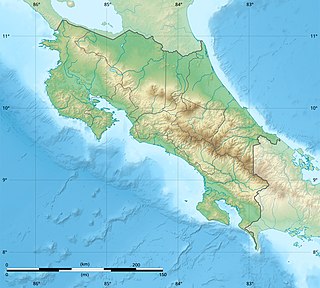
Aiphanes is a genus of spiny palms which is native to tropical regions of South and Central America and the Caribbean. There are about 26 species in the genus, ranging in size from understorey shrubs with subterranean stems to subcanopy trees as tall as 20 metres (66 ft). Most have pinnately compound leaves ; one species has entire leaves. Stems, leaves and sometimes even the fruit are covered with spines. Plants flower repeatedly over the course of their lifespan and have separate male and female flowers, although these are borne together on the same inflorescence. Although records of pollinators are limited, most species appear to be pollinated by insects. The fruit are eaten by several birds and mammals, including at least two species of amazon parrots.

Maquenque Wildlife Refuge, is a protected area in Costa Rica, managed under the Arenal Huetar Norte Conservation Area, it was created in 2005 by decree 32405-MINAE.
Beauprea congesta is a species of plant in the family Proteaceae. It is endemic to New Caledonia.
Beauprea crassifolia is a species of plant in the family Proteaceae. It is endemic to New Caledonia.

Helicia is a genus of 110 species of trees and shrubs, constituting part of the plant family Proteaceae. They grow naturally in rainforests throughout tropical South and Southeast Asia, including India, Sri Lanka, Indochina, Peninsular Malaysia to New Guinea and as far south as New South Wales.
Helicia amplifolia is a species of plant in the family Proteaceae. It is endemic to Papua New Guinea. It is threatened by habitat loss.
Helicia calocoma is a species of plant in the family Proteaceae. It is endemic to Papua New Guinea. It is threatened by habitat loss.
Helicia insularis is a species of plant in the family Proteaceae. It is endemic to Papua New Guinea. It is threatened by habitat loss.

Leucadendron discolor is a species of plant in the family Proteaceae. It is endemic to South Africa. It is threatened by habitat loss. In English the plant is known as the Piketberg Conebush and in Afrikaans as the Rooitolbos. L. discolor is a slow growing perennial. Growth of the root system and propagation, from a seed to the plant's first flower, can take up to two years. The male L. discolor 'Sunset' flowers exuberantly during early spring exposing a colorful flowerhead during this time.The flower head is composed of a dome-like receptacle, and is densely covered with small male flowers. These plants are only able to reproduce after their third year of life.
Neuburgia is a genus of plants in the family Loganiaceae. It is native to the Bismarck Archipelago, Caroline Islands, Fiji, Maluku Islands, New Caledonia, New Guinea, Philippines, Solomon Islands, Sulawesi, and Vanuatu. It contains the following species :
Neuburgia macrocarpa is a species of plant in the Loganiaceae family. It is endemic to Fiji.
Neuburgia tubiflora is a species of plant in the Loganiaceae family. It is endemic to Papua New Guinea.
Citrus oxanthera, synonym Oxanthera aurantium, is a species of plant in the family Rutaceae. Sometimes referred to commonly as the orange-flowered oxanthera, it is endemic to New Caledonia.
Roupala sphenophyllum is a species of plant in the family Proteaceae. It is endemic to Peru.
Stenocarpus villosus is a species of plant in the family Proteaceae. It is endemic to New Caledonia. It is threatened by habitat loss.
Terminalia ivorensis is a species of tree in the family Combretaceae, and is known by the common names of Ivory Coast almond, idigbo, black afara, framire and emeri.

Pentaclethra is a small genus of trees from the tropics. They are flowering plants in the legume family, Fabaceae. It belongs to the mimosoid clade of the subfamily Caesalpinioideae.
Carmenta surinamensis is a moth of the family Sesiidae. It was described by Heinrich Benno Möschler in 1878, and is known from Brazil, Surinam, Guyana, Trinidad, Panama and Costa Rica. The larvae of the species have been found on seeds of the plant Prioria copaifera, Pentaclethra macroloba, and plants in the genus Mora.

Pentaclethra macroloba is a large and common leguminous tree in the genus Pentaclethra native to the wet tropical areas of the northern Neotropics, which can form monocultural stands in some seasonally flooded habitats. It has giant, bipinnate leaves shaped like feathers. It uses seed dispersal by water to establish itself in new areas, having floating seeds that are left behind after the waters recede after floods or tides. It has hard timber which is not very resistant to rot in the tropics, but it can be treated, has a pretty pink-red colour when dry, and has a number of uses. Oil used in cosmetics is extracted from the large seeds. In the northern Amazon region the bark is used in herbal medicine as an antivenom, and in the Guianas the bark has been used as a fish poison. Despite their toxicity, the seeds are eaten by variegated squirrels, parrots and macaws, and serve as the nurseries of the larvae of the moth Carmenta surinamensis.

Prothysana is a genus of moths of the family Bombycidae. It contains two species, whose larvae are known as shag-carpet caterpillars. They are found from Mexico, south to Panama and into South America, at least to Ecuador.






